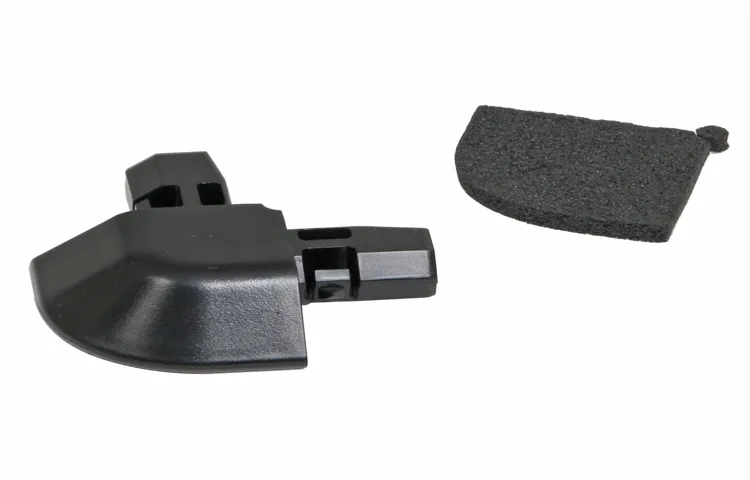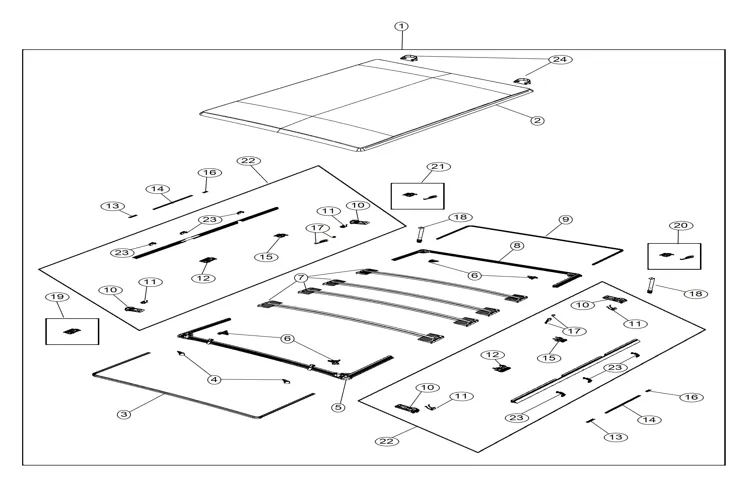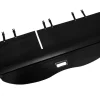So, you’ve finally decided to invest in a tonneau cover for your truck. Smart move! A tonneau cover is a practical and stylish accessory that not only protects your cargo from the elements but also enhances the overall look of your vehicle. But before you rush out to make your purchase, it’s important to understand the various parts that make up a tonneau cover.
Think of a tonneau cover as a puzzle, with each component fitting together to create a seamless and functional whole. The main parts of a tonneau cover include the cover itself, the mounting hardware, and the sealing system. Let’s break it down further to really understand what each part does.
First, we have the cover itself. This is the most visible part of the tonneau cover and comes in various materials such as vinyl, aluminum, or fiberglass. The cover is designed to fit snugly over the bed of your truck, providing a protective barrier against rain, snow, and debris.
Some covers roll up, while others fold or slide, allowing for easy access to your cargo. Next, we have the mounting hardware. This is what attaches the tonneau cover to your truck bed.
The mounting hardware often includes clamps or brackets that secure the cover in place, ensuring a tight and secure fit. Depending on the type of tonneau cover you choose, the mounting hardware may be adjustable to accommodate different truck bed sizes and styles. Lastly, we have the sealing system.
This is what prevents water, dust, and other elements from seeping into your truck bed. Most tonneau covers have a weather seal that runs along the edges of the cover, creating a barrier against moisture. Some covers also have built-in drain tubes or channels to redirect water away from your cargo.
Table of Contents
What is a Tonneau Cover?
If you are looking for an understanding of tonneau cover parts diagram, look no further! A tonneau cover is a protective cover that is used to cover the bed of a pickup truck. It is designed to protect your belongings from the elements such as rain, snow, and dust. There are different types of tonneau covers available such as roll-up covers, folding covers, hinged covers, and retractable covers.
These covers are made up of various parts that work together to provide the functionality and durability needed. Some of the main parts of a tonneau cover include the frame, the cover material, the mounting hardware, and the latches or locks. The frame provides the structure and support for the cover, while the cover material is what actually protects your belongings.
The mounting hardware ensures that the cover is securely attached to your truck bed, while the latches or locks keep it securely closed. By understanding the different parts of a tonneau cover, you can better understand how it works and how to properly maintain and repair it if needed.
Explanation of what a tonneau cover is and its purpose
A tonneau cover is a type of truck bed cover that is designed to protect the contents of your truck bed from the elements and secure them from theft. It is a great accessory for truck owners who frequently use their truck beds to transport valuable items or tools. Tonneau covers are typically made of durable materials such as aluminum or vinyl and come in various styles, including roll-up, folding, and retractable.
They are easy to install and can be customized to fit your specific truck model. Apart from protecting your truck bed, tonneau covers also improve fuel efficiency by reducing wind drag. They create a sleek and aerodynamic profile, which helps to minimize air resistance and increase fuel economy.
Additionally, tonneau covers give your truck a more polished and finished appearance, enhancing its overall aesthetics. Whether you use your truck for work or play, a tonneau cover is an essential accessory that offers both practical and aesthetic benefits. So, if you want to keep your truck bed secure and looking its best, consider investing in a tonneau cover.

Different Types of Tonneau Covers
Tonneau covers are an essential accessory for truck owners looking to protect their cargo and improve their vehicle’s overall appearance. But have you ever wondered how these covers are put together? Well, if you’re curious about the different parts that make up a tonneau cover, you’re in the right place. A tonneau cover parts diagram can give you a visual representation of all the components that come together to create a fully functional cover.
From the frame and hinges to the latch and seals, each part serves a specific purpose in ensuring that your tonneau cover is secure, weatherproof, and easy to use. Understanding the different parts of a tonneau cover can help you make more informed decisions when choosing the right cover for your truck, as well as assist you in troubleshooting any issues that may arise. So next time you’re shopping for a tonneau cover, take a moment to familiarize yourself with the parts diagram – it may just make your decision-making process a little easier.
Overview of the various types of tonneau covers available in the market
Tonneau covers are an essential accessory for truck owners, offering protection and security for the cargo bed. However, with so many options available in the market, it can be overwhelming to choose the right one for your needs. There are several different types of tonneau covers, each with its own unique advantages.
One popular type is the roll-up cover, which can be easily rolled open or closed, allowing for quick and convenient access to the truck bed. Another common option is the folding cover, which folds into multiple sections and provides flexibility in terms of bed access and cargo space. For those looking for maximum security, a hard shell cover is a great choice.
These covers are made from durable materials like fiberglass or aluminum and offer superior protection against theft and weather elements. Lastly, there are retractable covers, which slide open and closed along a track system, providing both convenience and security. Ultimately, the best type of tonneau cover for you will depend on your specific needs and preferences.
Whether you prioritize ease of use, security, or versatility, there is a tonneau cover out there that is perfect for you and your truck.
Main Components of a Tonneau Cover
Have you ever wondered how a tonneau cover works and what its main components are? Well, let me break it down for you with a tonneau cover parts diagram. The main components of a tonneau cover include the cover itself, the rails, the clamps, and the tensioning system. The cover is the most visible part of the tonneau cover and is usually made of durable materials such as vinyl or aluminum.
It is designed to protect the truck bed from the elements and keep your cargo secure. The rails are installed on the sides of the truck bed and serve as a base for the tonneau cover. They provide a secure attachment for the cover and allow for smooth opening and closing.
The clamps are used to fasten the tonneau cover to the rails and keep it in place. They are typically adjustable to accommodate different truck bed sizes. Finally, the tensioning system is used to keep the tonneau cover tight and secure.
It usually consists of a set of adjustable straps or springs that apply tension to the cover, preventing it from sagging or flapping in the wind. So, the next time you see a tonneau cover on a truck, you’ll know exactly what its main components are and how they work together to provide protection and security for your cargo.
Introduction to the key parts that make up a tonneau cover
A tonneau cover is a popular accessory for trucks that helps protect the bed and cargo from the elements and potential theft. Understanding the key components of a tonneau cover can help you make an informed decision when choosing one for your truck. The main components of a tonneau cover include the cover material, the frame or mounting system, and the locking mechanism.
The cover material can vary, with options such as vinyl, aluminum, or fiberglass. The frame or mounting system is what holds the cover in place on your truck bed, and there are various styles available, including roll-up, folding, or retractable covers. The locking mechanism is an important feature for security, with options ranging from simple latches to more advanced lock systems.
Considering these main components when choosing a tonneau cover will ensure that you find one that suits your needs and preferences.
Tonneau Cover Parts Diagram
Are tonneau cover parts diagram available? Absolutely! If you’re a truck owner who wants to learn more about the various components that make up a tonneau cover, you’re in luck. A tonneau cover parts diagram is a useful visual aid that breaks down the different elements of a tonneau cover, such as the cover itself, the mounting hardware, the hinges, and the latch system. It can help you understand how each part functions and how they all come together to provide the ultimate protection for your truck bed.
Whether you’re a DIY enthusiast looking to install or repair your tonneau cover or simply curious about the inner workings of these popular truck accessories, a tonneau cover parts diagram is an invaluable tool to have on hand. So, the next time you come across one, take a moment to study it and gain a deeper appreciation for the craftsmanship and engineering behind these versatile and practical truck accessories.
Visualization of the different parts with a detailed diagram
tonneau cover parts diagram When it comes to understanding the various parts of a tonneau cover, having a visual representation can be incredibly helpful. So, let’s take a closer look at a tonneau cover parts diagram. At the top of the diagram, you’ll see the cover itself, usually made of durable materials like vinyl or aluminum.
This is the part of the cover that provides protection and keeps your truck bed secure. Moving down the diagram, you’ll see the mounting hardware. This includes clamps or brackets that are used to secure the cover to your truck bed.
The hardware is designed to be sturdy and withstand the elements, ensuring that your tonneau cover stays in place even during rough driving conditions. Next, we have the rails. These are long, metal bars that attach to the sides of the truck bed and provide support for the cover.
The rails are an essential part of the tonneau cover, as they help to prevent sagging and ensure a snug fit. Now, let’s take a look at the latches or locks. These are the mechanisms that secure the tonneau cover in place and keep it from being easily opened.
Some tonneau covers have manual latches, while others feature automatic locks that can be operated with a key or remote. Finally, we have the weather stripping. This is a rubber or foam seal that is attached to the edges of the cover and helps to create a waterproof barrier.
The weather stripping ensures that no water or debris can enter the truck bed, keeping your cargo dry and protected. In conclusion, a tonneau cover parts diagram provides a valuable visual representation of the different components that make up a tonneau cover. From the cover itself to the mounting hardware, rails, latches, and weather stripping, each part plays an important role in ensuring the functionality and durability of the tonneau cover.
Common Tonneau Cover Problems and Solutions
Are tonneau cover parts diagrams readily available? Absolutely! Tonneau cover owners often encounter specific issues with their covers, and having a parts diagram can be incredibly helpful for troubleshooting and finding the necessary components for repair or replacement. Tonneau cover parts diagrams provide a detailed visual representation of every component and its placement, allowing owners to identify the exact part they need. These diagrams not only save time but also ensure that the correct part is ordered, minimizing the risk of frustration from receiving the wrong item.
So whether you’re dealing with a torn vinyl cover or a malfunctioning latch, having access to a tonneau cover parts diagram can be a real game-changer in resolving common problems efficiently.
Identification of common issues with tonneau covers and how to troubleshoot them
tonneau covers, troubleshoot, common issues, problems, solutions When it comes to tonneau covers, there can be a few common issues that can arise. One of the most common issues is a leaky cover. If you notice water getting into the bed of your truck, it could be a sign that your tonneau cover is not sealing properly.
The solution to this problem is to check the weather stripping around the edges of the cover and ensure that it is in good condition. If there are any tears or gaps, you may need to replace the weather stripping. Another common issue is a cover that won’t open or close properly.
This can be caused by a number of things, including a faulty latch or a misaligned cover. To troubleshoot this issue, you can try adjusting the latch or realigning the cover. If these steps don’t solve the problem, you may need to contact the manufacturer for further assistance.
Finally, some tonneau covers can be prone to fading or discoloration over time. To prevent this issue, it’s important to regularly clean and protect your cover with products specifically designed for tonneau covers. By addressing these common issues and following the appropriate troubleshooting steps, you can ensure that your tonneau cover functions properly and lasts for years to come.
Where to Find Tonneau Cover Parts
Are tonneau cover parts diagram readily available to the public? Absolutely! If you are in need of tonneau cover parts, you don’t have to fret about finding them. Many manufacturers and retailers offer tonneau cover parts diagrams on their websites. These diagrams can help you identify the specific parts you need for your tonneau cover, whether it’s replacement latches, clamps, seals, or any other component.
By using a tonneau cover parts diagram, you can ensure that you purchase the correct parts for your specific make and model of tonneau cover. Don’t waste time and money searching aimlessly for parts – check out the parts diagrams available online and order the parts you need today.
List of reputable sources to purchase tonneau cover parts
Where to Find Tonneau Cover Parts. If you own a truck with a tonneau cover, you know that it’s important to keep it in good working condition. Whether you need to replace a damaged part or simply want to upgrade your cover, finding reputable sources to purchase tonneau cover parts can be a challenge.
Luckily, there are several options available to help you find the parts you need. One option is to check with the manufacturer of your tonneau cover. Many manufacturers have websites where you can order replacement parts directly.
Another option is to visit an automotive store that specializes in truck accessories. These stores often carry a variety of tonneau cover parts and can provide expert advice on installation. Additionally, you can search online marketplaces such as Amazon or eBay, where you can find a wide selection of tonneau cover parts from various sellers.
Before making a purchase, be sure to read customer reviews and check the seller’s reputation to ensure you are buying from a reputable source.
Conclusion
As we bid farewell to our trusty tonneau cover parts diagram, let us take a moment to reflect on the beauty and complexity of such a simple yet essential piece of automotive engineering. Much like a well-crafted puzzle, this diagram has served as a guide, unraveling the mysteries of the tonneau cover and revealing its intricate inner workings. With the precision of a seasoned surgeon, it has dissected the cover’s anatomy, exposing the delicate relationship between hinges, latches, and straps.
As the saying goes, knowledge is power, and armed with this diagram, we have become masters of our tonneau cover universe. So let us raise a glass, or perhaps a toolbox, to the unsung hero that is the tonneau cover parts diagram – forever helping us keep our cargo safe, sound, and stylishly covered.”
Final thoughts on understanding tonneau cover parts
tonneau cover parts, where to find tonneau cover parts
FAQs
What is a tonneau cover?
A tonneau cover is a protective cover that is used to secure the bed of a truck or pickup. It helps to keep the cargo safe from weather elements and theft.
How does a tonneau cover work?
A tonneau cover is usually installed over the bed of a truck and can be made of different materials such as vinyl, aluminum, or fiberglass. It is designed to be easily folded or rolled up, allowing access to the cargo area when needed. When closed, it forms a secure barrier, protecting the contents of the truck bed.
Are tonneau covers easy to install?
Yes, most tonneau covers are relatively easy to install. They come with mounting hardware and instructions that guide you through the installation process. However, the installation process may vary depending on the type and brand of tonneau cover.
What are the benefits of using a tonneau cover?
Tonneau covers offer several benefits, including protection against weather elements, improved gas mileage, increased security for valuable cargo, and enhanced appearance of the truck. They also help to keep the truck bed organized and prevent items from sliding around during transit.
Can a tonneau cover be customized?
Yes, many tonneau covers can be customized to fit different truck models and bed sizes. Some brands offer options such as color choices, materials, and additional features like built-in locks or cargo management systems. It’s important to check with the manufacturer or a reputable dealer for customization options.
How do I clean and maintain a tonneau cover?
The cleaning and maintenance requirements may vary depending on the material of your tonneau cover. Generally, it is recommended to clean the cover regularly with mild soap and water. Avoid using harsh chemicals or abrasive cleaners that can damage the material. Periodic lubrication of hinges, latches, and locks is also necessary to ensure smooth operation.
Can a tonneau cover be used with other accessories?
Yes, tonneau covers are compatible with many truck accessories such as bed liners, bed extenders, and cargo management systems. However, it is important to choose accessories that are compatible with your specific tonneau cover model and brand. It is recommended to consult the manufacturer or a professional installer for compatibility information.



